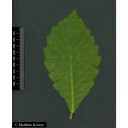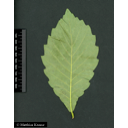Useful information about the taxon (species, subspecies, variety...)
Quercus dentata Thunb. 1784
Fagaceae
(APG IV)Japanese emperor oak, Daimyo oak
Akzessionnummer: EG-F-020-18789
Pflanzjahr: 2004
Patenschaftstext: Gestiftet von der Baumschule Hörmann 2004
Taxon concept: The Plant List (2014), version 1.1
Distribution: Japan, Korea, Northern and Western China
Quercus dentata Thunb. - Accepted: Quercus dentata Thunb. bei The Plant List (2014), version 1.1; Familie: Fagaceae (APG III)
- Flowers
- monoecious
- Flower ecology
- wind-pollinated (anemophilous)
- Life form
- tree
- Leaves
- oboval, dark green, coriaceous leaves with rounded to heart-shaped leaf base
- Foliage persistence
- deciduous to semi-evergreen
- Fruits
- acorns with cupule; cupule brownish tomentose with reflexed scales
- Soil conditions
- preferentially on acidic soils
- Natural occurrence (habitat)
- sunny slopes
- Bark
- thick, dark brown, strongly furrowed bark
- Altidudinal lower limit (sea level in m)
- 100
- Altitudinal higher limit (sea level in m)
- 2,700
Barbero, M., Loisel, R. & Quézel, P. (1992): Quercus ilex L. ecosystems: function, dynamics and management. Advances in Vegetation Science, 13: 19-34.; de Rigo, D. & Caudullo, G. (2016): Quercus ilex in Europe: distribution, habitat, usage and threats. In: San-Miguel-Ayanz, J., de Rigo, D., Caudullo, G., Houston Durrant, T., Mauri, A. (Eds.), European Atlas of Forest Tree Species.; Global Biodiversity Information Facilty (GBIF). Online Publication: www.gbif.org; The International Plant Names Index (2009). Published on the Internet http://www.ipni.org; Courtesy to IPNI, 2009. Exported from IPNI at date: 2009-09-22 20:17:51;
Diese Webseite verwendet Google Maps, um Karten und Standorte von Pflanzen in den Hohenheimer Gärten anzuzeigen. Dadurch werden unter Umständen Daten an Google weitergeleitet, was mit einer Verarbeitung Ihrer personenbezogenen Daten verbunden sein kann. Die Datenschutzerklärung von Google finden Sie hier: Datenschutzerklärung von Google


